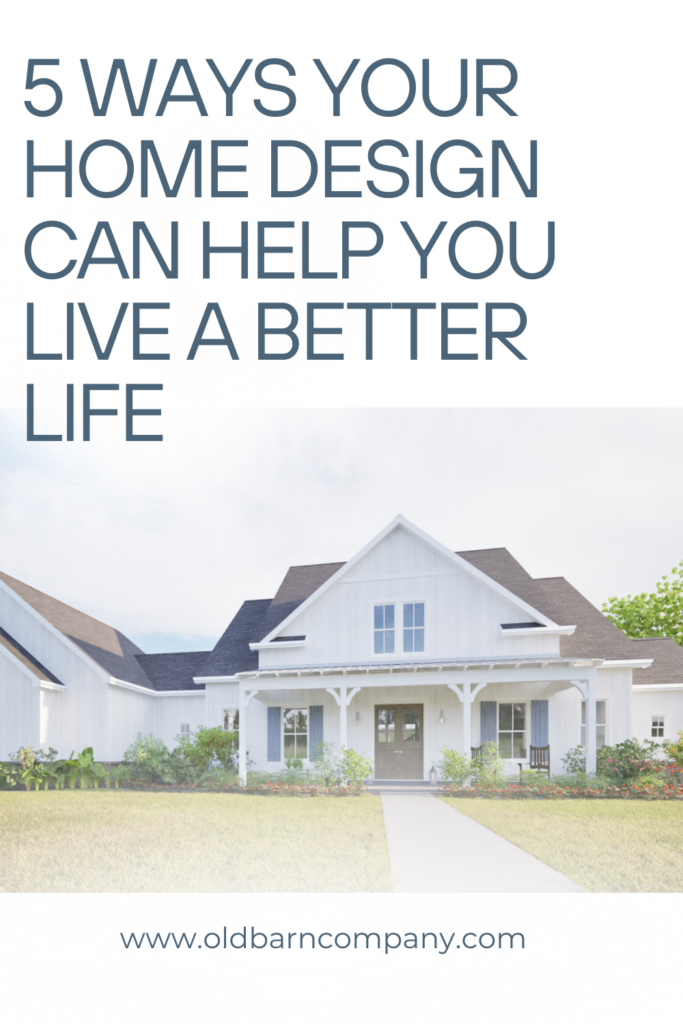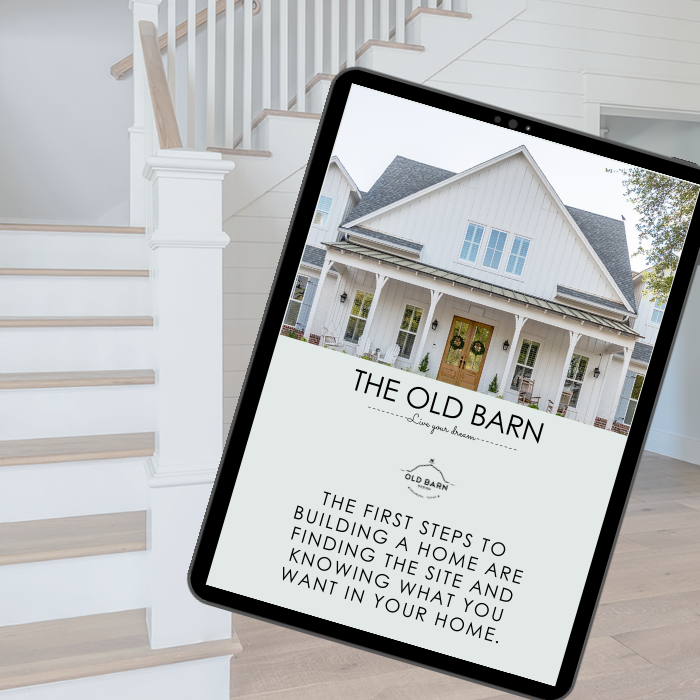
5 Ways Your Home Design Can Help You Live a Better Life

Our homes are far more than just the physical building we come back to after school, work, or parties; our homes play a huge role in shaping our daily experiences and overall quality of life.
We spend the vast majority of our time in our homes– we eat most of our meals at home, we sleep at home almost every night, and we make most of our memories with friends and family at home.
Since we spend so much time at home, why would we settle for a space that doesn’t meet our standard of living?
We believe that every facet of your home’s layout should work in service of your well-being; therefore, we believe that you can transform your life by transforming your home. In this blog post, we’ll explore five key ways that strategic home design can elevate your daily living experience and take your family from surviving to thriving.
1. Your home design can help you stay tidy and organized
Keeping a clean home can take a lot of effort and energy. You hardly have time for cleaning when you come home from work, and when you finally do find the time to tidy up, it seems like your kids destroy the house again in a matter of minutes.
We get it- keeping a clean home is hard!
However, a disorganized and cluttered home might be doing more damage to you and your family than you think. Studies have shown that an excess amount of clutter can cause a plethora of negative mental health effects, such as decreased focus, tension, and even feelings of depression and anxiety.
That’s why having a home designed for seamless organization and tidiness is so beneficial! Having a home specifically designed to keep clutter at bay takes some of the effort off of your hands, allowing you to spend less time cleaning and still reap the benefits of a tidy home.
Some home design elements that contribute to a tidy home include:
- Strategic closets
- Built-in shelving
- Under-the-stairs storage
- Designated zones for all your belongings
- A mudroom
When designing your home, think about things that will help you keep unnecessary clutter and messiness at bay. This small bit of forethought can help you and your family increase your focus, mental clarity, and mood!
2. Intentional home design reduces maintenance burdens
If you talk to any homeowner, you’ll hear them complain that one of the most burdensome aspects of homeownership is home maintenance.
Depending on how old your home is, how well it was built, and how well other tenants of the home have taken care of it, home maintenance can easily become a costly and time-consuming endeavor.
The wonderful thing about building your own home is that you have the opportunity to make decisions about building materials for yourself! To build a home that requires little maintenance, you should opt for high-quality, durable materials.
While we’re all for saving money wherever you can, we also think that building your home out of materials designed to last is a worthy investment. When choosing higher-quality materials for your home, you might think that selecting cheaper materials will save you more money; however, over the course of time, you’ll most likely end up spending more money in the long run.
For example, when deciding on wood flooring for our home, I wanted something that would withstand the wear and tear of our children and our dog while still looking nice.
The flooring we picked is INCREDIBLY durable and much more dimensionally stable than hardwood- we’ve had very few scratches and NO water damage, even on our kitchen floors! This has saved us a lot of frustration and kept us from wasting time and money on floor repairs.
Choosing intelligently designed elements means less maintenance and repair in the years ahead. Overall, your home should empower you to spend more time living life, not toiling over chores and repairs.
3. Forethought allows you to age in place
When we build our homes, we often don’t think about how well our homes will be able to support us as we age. We know that no one wants to think about getting older; however, it’s something you need to consider when you make decisions about your home design.
Most people would probably say that they would rather live out their lives in their own home instead of at a nursing home or in a retirement community- therefore, it’s important to build your home in a way that will allow you to do so!
The method of designing a home that is accessible for all people is called a universal home.
Common features of a universal home include:
- One-story: Stairs create mobility issues and can prevent people with mobility aids from enjoying every square foot of their home. In contrast, a one-story home keeps every room accessible to people with limited mobility! If you do choose
- Wide doorways, hallways, and extra space: Choosing a home design with extra space allows wheelchair users plenty of room to navigate the home with ease.
- Non-slip bathroom design: Incorporating a large, walk/roll-in shower with a built-in seat, handrails, or similar aids help prevent bathroom-related falls and slips.
- Door levers and cabinet handles: Something most of us don’t think about is that knobs typically require a lot of finger strength to grasp and open. For those with weak grip strength or even arthritis, this can present quite a challenge! To make all of the doors and cabinets in your home accessible for everyone opt for door levers and cabinet handles instead of knobs.
These are a few simple ways to make sure your home is accessible to everyone, regardless of their age or level of ability. With some planning, you can equip your home to accommodate your evolving accessibility needs and continue living independently for the entirety of your life.
Not only do these design choices allow you and your family members to age comfortably at home, but they also save you money!
Assisted living accommodations can be expensive. By considering accessibility when you build your home, you’ll save on the financial (and emotional) cost of moving to an assisted living community or retirement home.


4. Home design for meaningful social connections
Let’s face it– we are living in a digital age. Our devices completely capture our attention- are already-short attention spans are only getting shorter; as a result, we are becoming more and more isolated.
Instead of playing board games and chatting together, every family member retreats after dinner to their bedroom to endlessly scroll social media, binge-watch one of millions of shows, or game the night away.
What if the design of your home could contribute to your family disconnecting from their devices and reconnecting with one another? The first step in connecting with your loved ones is having a space in the home where everyone wants to hang out.
Concept of Hearth
When designing living spaces within a home, I try to consider the concept of the “hearth”. The hearth, in essence, is the focal point of a room. This can be the literal hearth of your fireplace, but this can also be a symbolic representation of a “hearth” in that it’s the thing in a room where everyone naturally gathers around.
When thinking about communal spaces in your home, you want to intentionally select a “hearth” that creates a sense of warmth, comfort, and togetherness.
Realistically, this won’t immediately make your entire family drop their phones forever– however, it’s the start of fostering an environment where connection with one another becomes a priority for every family member.
Porches as a means of connection
Another relational point of your home can be the porch. Think of the porch as the bridge between the rest of the world and your home. By inviting friends and family to gather together on your porch, you are telling them, “You are welcome here.”
Additionally, spending time on the porch allows you to spend more time outside, which has a plethora of health benefits that we’ll address in the next section!
When designing your porch, you should strive to choose a functional design and comfortable furniture that makes your friends and family excited to spend time outdoors!
5. Your home design can strengthen your connection to nature
We’ve already discussed how an intentional home design can improve your family’s mental well-being through organization. What if I told you your home design can impact your physical well-being as well?
It might sound a little crazy, but studies continually demonstrate the immense mental, physical, and emotional benefits of spending time outdoors and in natural light. Therefore, you can improve your overall health by incorporating natural light and outdoor gathering spaces into your home!
Windows and Natural Light in home design
One way to do this is by choosing large windows throughout your home, and by making sure every room has one. Realistically, it can be hard to spend time outside every single day. Sometimes we’re too busy, sometimes the weather is gross, and sometimes your kids just simply don’t want to, and it doesn’t feel like a battle you want to fight!
Although natural light through a window isn’t quite the same as spending time outside, natural light still can boost mood, brighten up a space, and even make spaces look larger than they are!
Additionally, when building your home, you’ll want to think of your home’s directional orientation. For the most optimal natural sunlight, you’ll want to design your home so that there are as many windows facing the south as possible.
Why? South-facing windows will filter in soft, indirect natural light throughout the day.
Although having natural light in the home has many benefits, what could be better than actually spending time outdoors? Time outdoors is known to have many health benefits, including Vitamin D from sunlight, fresh air, increased amounts of exercise, and improved mental health.
To help your family get outside and spend more time in nature, you should consider intentionally designing your home in a way that encourages time outside!
Ways to do this include:
- Utilizing your porch: Like we mentioned previously, having a comfortable gathering place on your porch will encourage your family to naturally spend more time outside. Even if everyone simply sits around and talks on the porch, your family still reaps the benefit of sunlight and fresh air!
- Ample backyard space: A good backyard provides ample opportunity to spend some time outdoors! Playing fetch with your pets, starting a game of tag with your kids, or even hosting a backyard barbecue are great ways to soak up the sun while fostering your relationships with the ones you love.
- Starting a garden: A fun and interactive way to help your kids enjoy the outdoors more is to start a garden! Plant a simple flower bed for your family and guests to admire, or work together as a family to plant produce that everyone can enjoy!
Your home is more than just a place to live; your home is the place where most of your life happens. With some intentionality, you can ensure that every aspect of your home works to serve the needs of you and your family!
Want to learn more about saving money on your home build?
If you’re ready to start your homebuilding journey but you’re not sure where to start, we have plenty of resources to help even the most novice builders take agency over their home-building process.
Our First Steps Guide helps you set your budget and priorities, and our Bootstrap Builders Program provides you with the knowledge and resources you need to make your dream home a reality.
With a little bit of effort, planning, and passion, you can get started building a home that’s perfect for you!

- Why “Boring” Is Better: The Smart Way to Choose Finishes for Your New Build
- The Beauty of Negative Space in Home Design: Simple Elegance of “Less is More”
- Let’s Breakdown How Builders Add Fees on Top of Subcontractor Costs: What Homebuyers Should Know
- Answering Your Home Insulation Questions
- 10 Simple Home Design Ideas for Lazy People
